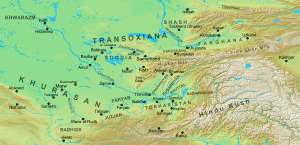
Back بلاد ما وراء النهر Arabic ترانسوكسيانا ARZ Mavəraünnəhr Azerbaijani ماوراءالنهر AZB Мәүәрәннәһер Bashkir Маверанахр Byelorussian Трансоксиана Bulgarian মাওয়ারান্নাহর Bengali/Bangla Transoxiana Catalan Transoxanie Czech

Transoksijana poznata i kao Mā Warāʾ an-Nahr (arapski: ما وراء النهر) ili Farârud (perzijski: فرارود) je antički naziv koji se koristio za dijelove Srednje Azije a koji otprilike odgovara području današnjeg Uzbekistana, Tadžikistana, južnog Kirgistana i jugozapadnog Kazahstana. Geografski gledano, regija Transoksijana obuhvatala je prostor između rijeka Amu-Darje i Sir-Darje. Područje je antičkim Irancima bilo poznato kao Turan, izraz koji se u koristio i u perzijskom nacionalnom epu Šahname,[1] dok su Rimljani za istu regiju koristili naziv Transoksanija, što znači Zemlja preko Oksusa, (Oksus - grčki naziv za rijeku Amu-Darja). Arapski izraz Mā warāʼ an-Nahr (Zemlja iza rijeke) počeo se koristiti i u perzijskoj književnosti i ostao je u upotrebi sve do postmongolskog perioda.[2]
Regija je bila jedna od satrapija (pokrajina) perzijskog Ahemenidskog carstva pod nazivom Sogdijana. U klasičnom periodu pojam treba razlikovati od pojma koji se koristi za današnji Iran, posebno od njegove sjeveroistočne pokrajine Korasan[3] - izraza koji potiče od Sasanida.[4] Međutim, kod ranoarapskih historičara i geografa postojala je tendencija da se pojam Transoksijane podvede pod izraz Horasan koji označava mnogo veću teritoriju.[5][6] Teritorije Horezma, Sogdijane, Čaghanijane i Kutala nalazile su se u južnom dijelu Transoksijane dok su se Taškent, Osrušana i Fergana nalazile u sjevernom dijelu.[7]
- ^ Sabloff, Paula L.W. (2011). Mapping Mongolia: Situating Mongolia in the World from Geologic Time to the Present. Philadelphia: University of Pennsylvania Museum of Archaeology and Anthropology. str. 62. ISBN 978-1934536186. OCLC 794700604.
- ^ C. Edmund Bosworth, (2002), 'CENTRAL ASIA iv. In the Islamic Period up to the Mongols' Encyclopaedia Iranica (online)
- ^ Svat Soucek, A History of Inner Asia, Cambridge University Press, 2000, p.4
- ^ "Khorāsān". britannica.com. Encyclopædia Britannica, Inc. Pristupljeno 22. 5. 2020.
- ^ C. Edmund Bosworth, (2002), 'CENTRAL ASIA iv. In the Islamic Period up to the Mongols' Encyclopaedia Iranica "In early Islamic times Persians tended to identify all the lands to the northeast of Khorasan and lying beyond the Oxus with the region of Turan, which in the Šāh-nāma of Ferdowsī is regarded as the land allotted to Ferēdūn’s son Tūr...At the outset, however, those nearby parts of Central Asia with which the Arabs were familiar were often subsumed into the vast and ill-defined province of Khorasan, embracing all lands to the east of Ray, Jebāl, and Fārs." (online)
- ^ C. Edmund Bosworth, (2011), 'MĀ WARĀʾ AL-NAHR' Encyclopaedia Iranica " It was defined by the early Arabic historians and geographers as the lands under Muslim control lying to the north of the middle and upper Oxus or Āmu Daryā, in contrast to Iran proper and its eastern province of Khorasan, sometimes called Mā dun al-nahr (lit. “what lies this side of the river”), although from the perspective of Arab historians writing in distant Iraq, the term “Khorasan” might extend to all lands beyond the Oxus, including Khwarazm and Transoxiana." (online)
- ^ Dickens 2018, str. 1531–1532.